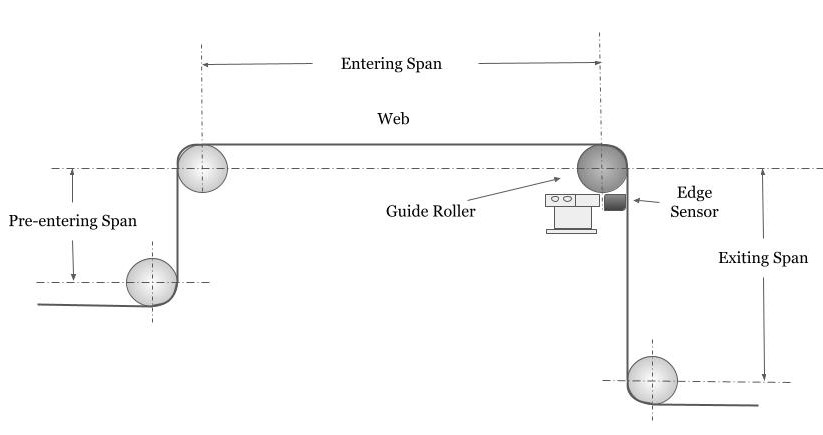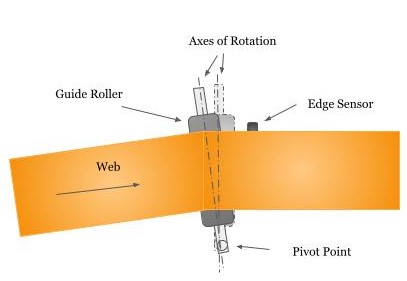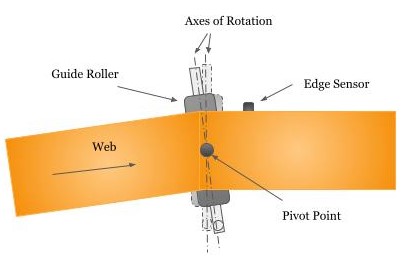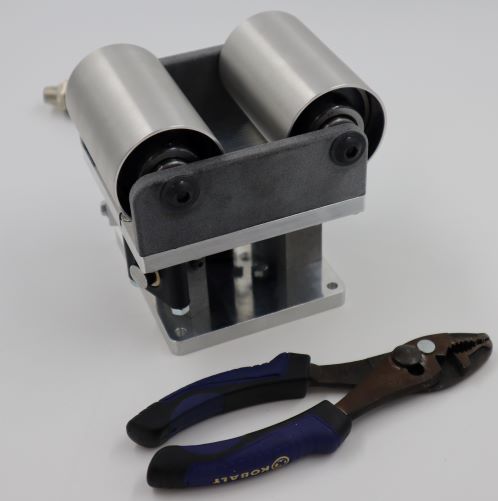End and Center Pivot Guides - Not a commonly used web guide in the industry
End and center pivot guides do not displace the web, they only have the angle of rotation to reposition the web. This makes them very slow in term of response, and therefore, are not an ideal choice in web guiding options.
Terminal web guides such as unwind and rewind guides and intermediate guides such as displacement guides and steering guides are the most commonly used web guides in the converting industry.
Unwind guides are used at the start of a converting line, and the roll is mounted on a carriage or side-lay that will move to correct the position of the web based on the detected edge of the web.
Rewinds web guides, as we have seen in previous posts, have the roll mounted on a carriage or side-lay, but it actually repositions the carriage as it chases the position of the web.
Displacement guides are the best type of web guiding system as it eliminates any bending stresses on the web, if the guide is designed and installed correctly. Steering guide are best when the web is coming out of a very long span, for example, at the exit of an oven.
However, there is a lesser known web guide design that is not very efficient and is not usually found in new converting operations. These are end and center pivoted web guides.
How end and center pivot guides work
End and center pivoted web guides work by using the normal entry rule to guide or steer the web. By using the normal entry rule, these web guides subject the web to bending and therefore, stresses on the web.
As with other intermediate web guides, they follow the same requirements in parameters of the pre-entering span, entering span and exiting span. Pre-entering span should be shorter than the entering span, the sensor should be as close as possible to the guide roller on the exiting span, the exiting span should be perpendicular to the exiting span, and wraps angles around the rollers should be close to 90o.

As in other types of guides, poor installation will cause wrinkles, creasing and possible web tear depending on web material and thickness.
End Pivot Guides
End pivot guides will have the axis of rotation at the end of the guide roller shaft. Both ends of the roller will have the same amount of angular displacement, but the end of the roller farthest from the pivot point will have the most amount of arc length. The end of the roller closest to the pivot point will have less arc length.

This action changes the plane of motion of the guide roller. The web will adjust its position as dictated by the normal entry rule.
Center Pivot Guide
Center pivoted web guides have the angle of rotation at the middle of the guide roller. Unlike the end pivoted web guide, the angular displacement is the same at both ends of the guide roller. Both ends of the guide roller will have the same arc displacement, in directions opposite to each other.

The rotation of the guide roller at the middle of the guide roller length changes the plane of motion of the guide roller. Like the end pivoted web guides, this change in plane of motion will cause the web to adjust its position until it is perpendicular to the roller axis, as the normal entry rule dictates.
Use of end and center pivoted web guides
As mentioned before, the use of end and center pivoted web guides is not recommended for converting operations. However, these can be found in machines processing narrow webs with rollers and equipment with cantilever installation, and lines that have very limited spaces.
We do have displacement guides for very narrow width applications. These web guides allow converters to place a web guide in small spaces to handle narrow webs under 2 inches.

You have a end or center pivot web guide: what can you do?
Start off by getting in touch with us so we can guide you to a solution of your particular issue. Our technical team would be there for you through every single step of the process until a solution is found.
In our next blog post we will address an important component of a web guiding system: actuators.
If you like our posts, follow us on linkedin, facebook, or youtube. You can always contact us directly to discuss a particular application for your operation.
